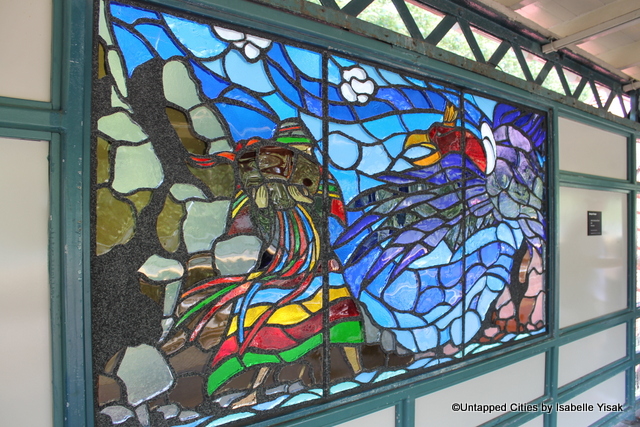A subway station is home to two extremes: the harried commuter whose mind is split between the time and not spilling his coffee while doing that awkward combination of walking and jogging, and the stationary traveler who waits for the approaching train. However, armed with an iPhone and camera, my mission was not to frantically arrive at a destination on time but to examine fixed artifacts at several stations: the subway art.
This exploration into the underground was made possible by the app, Arts for Transit, which Untapped introduced in a past article. However, this article and following ones will go over artworks that I find to be notable, whether because of their initial obscurity, interactivity with commuters, locality, or just general delightfulness.
Line 1
116th Street-Columbia University
Brief and straightforward, the title of Michelle Greene’s installation, Railrider’s Throne, is just what it implies. When I entered this station, one gentleman had already claimed ownership to the seat. Calmly reading his newspaper on this kingly chair, he certainly fit the image of royalty. According to Greene, “I wanted to create a whimsical environment that allows the commuter to feel special as opposed to alienated.” Well, with the functionality of a comfortable resting place among travelers along with its abstracted regal design, this work has constant interaction with the station’s temporary inhabitants.
Out of the many mosaics that adorn the MTA subway, Deborah Brown’s Platform Diving adds quite a playful nature to this station. With beluga whales, turtles, and manatees making their underwater commute, Brown mischievously places these itinerant animals right behind their human counterparts.
Line 2
George Crespo’s Latin American Stories is a highly contextual series of stained glass windows at this Bronx subway station, located in the only borough with a majority of Hispanic residents. Six narratives span both sides of the platform, each illustrating a different regional fairytale from Latin America.
While aware of the local demographics, Crespo is also conscientious of the station’s elevated status. With a natural abundance of light, his choice to use stained glass windows strengthens the effects of the images with soft manipulations of light.
Crespo’s awareness of location, whether it be the current physical setting or the past homes of the neighborhood’s residents, works to create mementos that pay homage to the heritage of Latin American immigrants.
Atlantic Avenue-Pacific Street
Despite the detailed directions given by the app, I spent several minutes hunting for George Trakas’s Hook (Archean Reach), Line (Sea House), and Sinker (Mined Swell), that is, until I realized that I hadn’t properly looked above me.
Working in conjunction with the architects, the surrounding space and installation of this particular passageway were meant to harmonize with each other. Trakas’s work, a steel sketch of a sailboat, echoes the material that accentuates the structure’s interior. With the architects’ installation of a skylight and the vast space below the artwork, Trakas’s “boat” seems to float of its own accord, above a sea of commuters.
Line 3
Another one of my top mosaics includes Vincent Smith’s Minton’s Playhouse (uptown), The Movers and Shakers (downtown). Like George Crespo’s stained glass windows in the Bronx, Smith’s artwork is a tribute to the neighborhood where the station is located. In this case, this series of mosaics pay homage to the past notable residents of Harlem.
In addition to vivid glass pieces, the slanted and curved lines of the mosaic pieces enhance the sense of movement and liveliness of a past era.
Times Square Station Complex
While technically not in the subway, the MTA app includes Max Neuhaus’s sound installation. Unnamed and unmarked, I wouldn’t have noticed this artwork if I wasn’t deliberately roaming around the pedestrian area on 46th Street. With the cacophony that is Times Square, it was difficult at first to discern any distinct sound from below. However, perhaps earlier or later in the day (definitely not during rush hour when I was there) maybe you can hear the deep, organ-esque sounds that flows upward from the grating.
Bonus!
There is one work of art at the Times Square hub which is not on the app. The artwork in question, The Commuter’s Lament or A Close Shave by Norman B. Colp, can be found in the passageway from the 8th Ave./42nd St. station to the Times Square station. Situated on the overhead beams, Colp cleverly placed his installation there for the despondent and weary commuter. Untapped previously covered this in our series about Sequence Art in NYC.
Get in touch with the author @iyisak


















